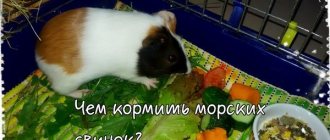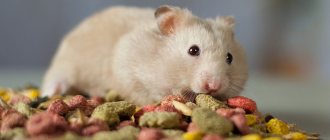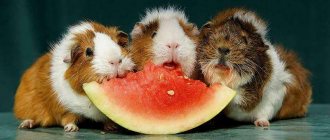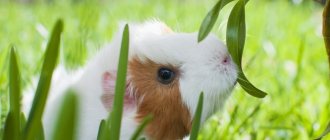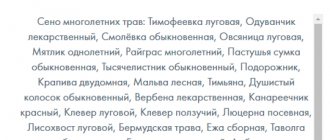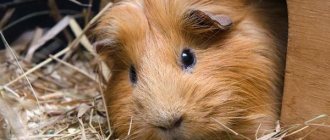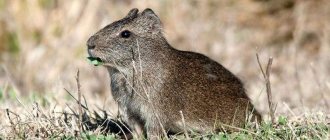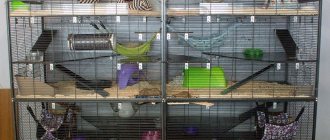Guinea pigs belong to the order of rodents of the pig family. The homeland of the animal is South America. Now they are distributed all over the world as cute pets. Tamed pigs respond to names and love to interact with people. Owners choose natural products or commercial food for their pets. Eating natural products brings more worries: always buying fresh and different assortments, vitamins, mineral stones. Factory packages always contain a balanced composition of ingredients.
Feed composition. What to look for
The guinea pig is a true vegetarian, with a capricious digestive system. There are a number of ingredients that are unacceptable in their diet:
- molasses or sugar
- animal proteins (bone and fish meal are not digestible)
- whole grains of corn and legumes (if they are too dry, they can get stuck between the teeth. This can cause refusal of food, and further death of the animal).
Acceptable ingredients:
- cereals (the best option is in the form of flakes or puffed grains)
- herbal granules
- dried leaves
- flowers and herbs
- twigs and bark of some trees
- dried vegetables.
The presence of peanuts and sunflower seeds is also acceptable. But due to the high fat content, it must be kept to a minimum. The content of berries and dried fruits should also be minimal. They are sources of not only vitamins and minerals, but also sugars, which, in turn, can trigger the development of diabetes.
The best treats for guinea pigs
Once a week, you can arrange a belly celebration for your pet, and treats in the form of sticks or pads will help with this.
They consist of fruits, nuts and other goodies. They should not be abused so as not to cause obesity and increased blood sugar in the rodent.
Titbit Tartlets
4.8
★★★★★
editorial assessment
90%
buyers recommend this product
Baskets made of unleavened dough with a delicious filling of pumpkin and pineapple will please any rodent. The tartlet base consists of first grade flour, corn, potatoes and oats.
The special structure helps clean the pig's teeth from plaque and strengthen the gums. Pumpkin saturates the body with carotene and beneficial minerals, and pineapple is rich in sucrose and ascorbic acid. There are 8 such tartlets in the box.
Pros:
- Original form;
- Tasty and healthy filling;
- Contains carotene, as well as a lot of micro- and macroelements;
- The hard dough basket strengthens and cleans teeth;
- Suitable for pigs of any age;
- There are 8 tartlets in a package.
Minuses:
- Lots of carbohydrates and sugar;
- The filling falls out.
The unusual presentation is not fully thought out; in some baskets, the middle with tasty treats falls out. You should not give more than one treat at a time due to the high carbohydrate content (60%) and only 6% fiber.
Review of popular foods
| Name | Manufacturer | Average cost RUR/kg |
| JR Farm Classic | Germany | 335 |
| Menu Vital | Vitakraft, Germany | 450 |
| Cavia Complete | Versele-Laga, Belgium | 660 |
| Chica-bio | Russia | 400 |
| Littleone Green Valley | Mealberry, (Russia-Germany) | 300 |
| Karma | Vitapol, Poland | 300 |
| Littleone Guenea Pigs | Mealberry, (Russia-Germany) | 240 |
| Sultan | Russia | 175 |
| Animals | Zoomir, Russia | 160 |
| Baka High quality | Russia | 140 |
| Dusya | Zoomir, Russia | 130 |
All foods presented in the review are enriched with vitamins and minerals necessary for complete and proper nutrition. All formulations contain dried vegetables. Let's consider how they differ from each other, what are the advantages and disadvantages.
Rules for storing hay at home
Almost all pet stores sell hay packaged in plastic bags. After the expiration date, you risk purchasing a rotten mixture.
Rules for storing hay at home:
- Regardless of whether you bought hay or prepared it yourself, store the mixture only in open form.
- The humidity in the room where hay is stored should not exceed 40% in summer and 50% in winter.
- Turn and loosen the hay regularly to allow it to “breathe.”
If storage rules are violated, dry grass begins to rot. At first, a barely noticeable, sweetish odor appears. Afterwards the mixture begins to heat up and rot. As hay rots, mold may form on the hay.
JR Farm Classic
Treat as a combination food for guinea pigs.
Advantages:
- fiber content -15.6%
- a variety of herbs that are included in the animals’ natural diet and help reduce the likelihood of weight gain and healthy digestion
- cereals and legumes, aerated and in the form of flakes
- natural sources of vitamin C – parsley and clover
Flaws:
- Herbal granules in the composition are not to the taste of all pigs
- contains whole corn kernels
Nutrition for pregnant pigs and newborn piglets
Pregnant pets must eat well and of high quality. The diet of furry mothers should be rich in proteins and vitamins. It is useful to give pregnant females carrots, beets, and wheat sprouts. You can periodically add a little milk to the water. Rosehip infusion brings great benefits to the body of a pregnant pig.
If the female who gave birth does not have milk, then the owner will have to feed the cubs on his own using a syringe. Artificial food for small piglets includes low-fat cream and the probiotic Linex. The cream is taken into the syringe and a tenth of the probiotic capsule is added to it. The resulting solution is nutritious and beneficial for the digestive system of babies. The food in the syringe is warmed to room temperature. Piglets take 1 ml of food every hour. Two-week-old babies can be switched to cereal porridge without milk. The piglets sit on the porridge until they get used to “adult” food.
Animals
| Advantages | Flaws |
|
|
What not to feed
There are foods that are prohibited for guinea pigs, and it is worth saying that this list is quite long.
So, the prohibited ones include:
| Cereals and potatoes | Horseradish, radish, garlic |
| Dairy products, including cream, milk, cottage cheese | Burdock, sorrel, spinach |
| Smoked meats and various pickles | Any inflorescences, chestnuts, mushrooms |
| Winter products - tomatoes, cucumbers, watermelons | Pasta, bakery products |
| Confectionery | Salad mustard, green onions |
| Fish, eggs, meat | Sugar, table salt, sweet tea |
It is also worth knowing that branches of trees such as rowan, hornbeam, buckthorn, pine, oak, larch, elm, spruce, and willow are prohibited. Since you simply cannot do without wood, shoots of hazel, apple, cherry, plum, gooseberry (be careful, without thorns), apricot, hawthorn, blueberry, and pear are recommended.
Baka High quality
– the best dry food from the Vaka brand line, which has received the maximum number of positive customer reviews.
Pros:
- enriched with probiotic,
- eaten completely, without waste,
- price.
Minuses:
- predominance of cereal crops,
- Contains bone meal, yeast, and salt.
Additional sources of vitamins and minerals
Most of all, a guinea pig needs vitamin C. Ascorbic acid is not synthesized at all in the body of rodents of this species. Therefore, animals must daily absorb a significant amount of food saturated with vitamin C. Phylloquinone and B vitamins can be absorbed in the guinea pig’s body only after repeated consumption, that is, after the animal eats its own feces. Therefore, a rodent that eats droppings cannot be stopped.
Of the minerals, salts and calcium are especially important for guinea pigs. Therefore, it is recommended to buy mineral sticks for your pet at the pet store. It is also permissible to treat your rodent with fish oil and bone meal as useful supplements.
Menu Vital
– leader in the line of feed from the German company Vitakraft. This manufacturer's product range includes both basic products and premium foods: combined, granulated, and even for animals with sensitive digestion.
Advantages:
- enriched with vitamin C, linoleic acid, zinc and biotin, which has a positive effect on the body’s condition
- contains Yucca Schidigera extract - a source of vitamins C and B, as well as minerals: calcium, iron, magnesium and phosphorus. It is added to animal feed to strengthen the immune system and prevent inflammatory processes in the digestive system.
- different packaging
Flaws:
- high percentage of grain content
- presence of food coloring
Laurie Rocky 2 Super Menu
The above-mentioned foods are not all that can be offered to your rodent. For those who value quality and a loyal pricing policy, we recommend Lori Rocky 2 Super Menu. This is a complete food offered for guinea pigs.
Here you can find dried fruits, cereals, seeds, dried apricots, raisins, as well as various compositions that look like cute balls and rings. There are trace elements and minerals necessary for the health of your pet. You can also see additives in the food: lysine, phosphorus, amino acids, zinc and more. Don’t forget about the vitamins that are present in abundance in this diet.
Manufacturers also took care of treats, so in addition to food, there is an opportunity to pamper your furry pet with treats.
Littleone Guenea Pigs
| Advantages | Flaws |
|
|
You can buy it here.
The best pelleted foods
Pressed products are found among all types of food for pigs, but there are separate fees for the main diet.
Granules are good because they contain all the necessary components, help grind teeth, but do not crumble like grains and do not create debris in the cage.
Dajana Exclusive Country Mix
4.9
★★★★★
editorial assessment
91%
buyers recommend this product
Complete food suitable for adults. It is made using cold extrusion technology, which preserves all nutrients and vitamins. The basis is meadow hay, wheat, bran, yucca, rosemary, sunflower, rose hips and lemon balm.
The granules are held together by omega-3 fats (from flax seeds), apple and carrot pulp. Brewer's yeast is used to increase appetite and assimilate ingredients.
Pros:
- Contains fiber and protein;
- Strengthens the immune system;
- Helps with grinding teeth;
- Helps improve the pet's appearance;
- The composition includes a probiotic – inulin;
- Pleasant taste and aroma.
Minuses:
- Yeast included;
- Dye used.
Yucca extract relieves bloating, normalizes the digestive tract and reduces unpleasant odor from your pet. There are two types of packaging to choose from: 500 and 1500 g.
JR Farm Grainies Complete
4.8
★★★★★
editorial assessment
87%
buyers recommend this product
Economical and relatively inexpensive food is suitable for pigs of all ages. The main ingredient is meadow grass, and as an addition there are pea and bean flakes, flax seeds, caraway seeds, cubes of apples, carrots and beets.
The mixture contains fennel, which relieves bloating and intestinal colic, as well as chamomile, which is responsible for resisting diseases. Hard granules imitate the density of bush branches and help clean and grind teeth.
Pros:
- Large packaging;
- The contents are clearly visible in a transparent bag;
- High-quality raw materials;
- Pleasant herbal smell;
- Chamomile and fennel relieve irritation in the intestines;
- Suitable for pets of all ages;
- Lots of fiber, minerals and ash.
Minuses:
- Inconvenient package;
- It crumbles a lot and has a chemical smell.
It is impossible to constantly feed pigs with dry formula. It is necessary to introduce fresh vegetables, herbs and other components. The packaging is quite large - 1350 g, so it is consumed slowly.
Littleone Green Valley (or Green Valley)
– grain-free food containing 60 types of herbs, with the addition of fruits, berries and seeds
| Advantages | Flaws |
|
|
What to do if your pig refuses to eat hay
The owner should be concerned if the pig refuses to eat hay. There are many possible reasons, but the most common ones are:
- Stale or rotten hay.
- The presence of poisonous herbs in the mixture.
- Problems in the gastrointestinal tract.
If your pet appears lethargic or weak while refusing hay, contact your veterinarian immediately. All diseases and dangerous conditions in guinea pigs develop rapidly, so delay can cost the pet’s life.
Sultan (Sultan)
| Advantages | Flaws |
|
|
Water
Having a fresh portion of drink in your pet's cage is a must. 250 ml is enough for one animal. Pregnant females require more fluid.
It is wrong to use boiled water. Filtered or bottled water will do. The cleanliness of the drink must be carefully monitored, since an infection can enter the animal’s body along with garbage.
It is recommended to use an automatic waterer, which will be a constant source of water for the pigs. With such a drinker, the water will be protected from contamination and spillage.
Karma
| Advantages | Flaws |
|
|
How many times a day to feed
The first thing to remember is that the rodent does not have to immediately eat the entire portion that the owner gives him; he can finish it later, which is quite normal. Therefore, bowls of water and food are always available. But you need to feed her 2-3 times a day.
It is correct to feed succulent food in the first half of the day; in the second half, the emphasis is on dry food. If a pet receives two meals a day, then at one time he needs 0.5 tablespoon of dry food, with three meals a day, 1/3 tablespoon.
When a rodent eats the main portion of food, it switches to dry grass; its body is designed in such a way that it constantly needs food, otherwise the intestines stop. Therefore, it is strictly forbidden for him to go hungry, and he simply must not remain without food.
Cavia Complete
– the most popular product from Versele-Laga. This is granular food.
| Advantages | Flaws |
|
|
Recommendations for the selection and use of dry food
When choosing, it is necessary to take into account the age and breed of the guinea pig, its state of health and the time of year. For females, an additional criterion is pregnancy and lactation.
- The pet store must be verified. It is better if the establishment provides a free consultation with a veterinarian.
- During the harvest season, the feed should contain a minimum of dried fruits and vegetables. During this period, it is necessary to give your pet fresh fruits.
- Foods high in sugar, nuts, corn, dried fruits, beet pulp and animal proteins should not be fed every day. You can set aside special “holiday” days for this delicacy.
- A sick animal needs special care. Your veterinarian will help you choose food for your pet.
- It is recommended to stock up on two or more types of food, then use the behavior and well-being of the animals to understand which is better. Feeds can also be mixed with each other.
- It is better to give preference to a mixture that consists of granules of a natural color (without dyes) and has a herbal smell.
- Dry food should not make up your pet's entire diet.
- Dry food should be kept in a cool place protected from light.
Chica-bio
– premium grain-free mixture. Ideal for juveniles and lactating females. It contains only herbal granules, hay, twigs, vegetables, and fruits.
| Advantages | Flaws |
|
|
List of approved products
The diet of guinea pigs is based on foods such as vegetables, fruits, berries, garden and meadow greens, sunflower seeds, seeds, twigs of trees and shrubs.
Healthy and safe food for guinea pigs:
- Vegetables - cucumber, carrots, beets, pumpkin, fennel, zucchini, turnips, parsnips and celery in tubers. In small quantities you can treat your pet to bell peppers, tomatoes, artichokes, cauliflower, rutabaga, and Jerusalem artichoke.
- Fruits – seedless grapes, plums, apples, pears. Bananas, peaches, apricots, watermelon, melon, kiwi, pineapples, oranges and tangerines are served in small quantities.
- Berries - currants, raspberries, blueberries, cherries, sweet cherries, strawberries. In limited quantities - gooseberries, sea buckthorn, blackberries, cranberries, rowan.
- Garden greens - lettuce leaves, dill, celery, sprouted cereal grains, carrot tops, beets, corn cobs. In limited quantities - cilantro, spinach, parsley.
- Meadow greens - nettle, clover, yarrow, alfalfa, plantain, sage, echinacea, burdock, chamomile. Milk thistle, coltsfoot, dandelion, St. John's wort, wormwood, and fireweed are served in small quantities.
- Flax seeds are useful. In limited quantities - sesame seeds, dill, pumpkin and sunflower seeds.
- Useful branches of bushes and trees - birch, mulberry, hazel, pear, raspberry, ash, hawthorn, blueberry, maple and cherry plum. Sometimes you can pamper your pet with branches of chestnut, cherry, aspen, apricot, cherry, willow, poplar and rowan.
- It is not often that a rodent can be fed green peas and asparagus in small quantities.
Dusya
- another product of the Zoomir company. In composition, it is not much different from Zverushka’s food. But, according to reviews from animal owners, it is much better eaten.
| Advantages | Flaws |
|
|
